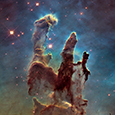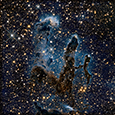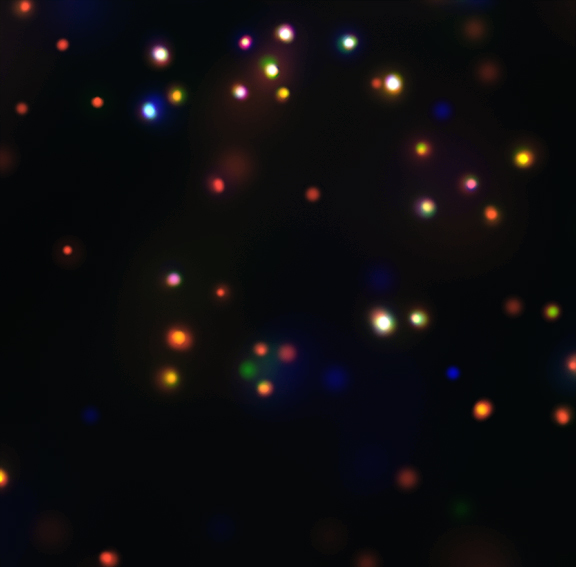
The Eagle Nebula in 3D
The Eagle Nebula, or Messier 16, is the site of the spectacular star-forming region known as the “Pillars of Creation”. Within the towers of gas and dust standing light-years tall, new stars are being born.
The Pillars of Creation are a fascinating, but relatively small, feature in the southern part of the Eagle Nebula. The Eagle Nebula spans about 55 light-years across. The nebula is located in the Milky Way galaxy about 7,000 light-years from Earth in the constellation Serpens.

This region of star formation contains the Pillars of Creation, which was made famous by the Hubble Space Telescope is shown in an image from 2024 that combines infrared data from NASA’s Webb (red, green, and blue) and X-rays from NASA’s Chandra (red, yellow, green and blue point sources). Credit: X-ray: NASA/CXO/SAO; Infrared: NASA/ESA/CSA/STScI; Image processing: NASA/CXC/SAO/L. Frattare
The Pillars of Creation became famous after NASA’s Hubble Space Telescope first imaged them in 1995 using its Wide-Field Planetary Camera 2. A larger segment of the Pillars was then observed in late 2014 with a more advanced camera on Hubble called Wide Field Camera 3.
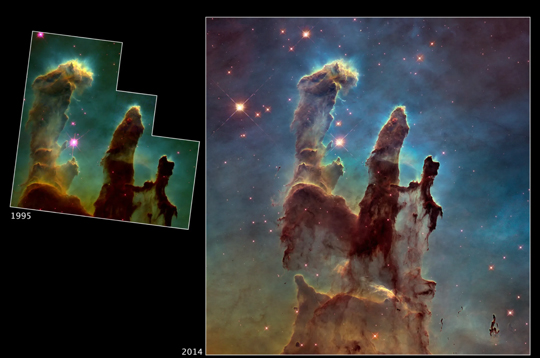
Astronomers using NASA's Hubble Space Telescope assembled multiple images of the Eagle Nebula's "Pillars of Creation" in 2014 (right) with the original 1995 Hubble image shown at left. NASA/ESA/Hubble Heritage Team (STScI/AURA)/J. Hester, P. Scowen (Arizona State U.)
The Pillars in Different Kinds of Light
Images taken in different wavelengths of light reveal different structures, each providing more information about the structure of the Pillars.
In Hubble’s 2014 image of the Pillars, the blue colors represent oxygen, red is sulfur, and green reveals both nitrogen and hydrogen. The Pillars are bathed in the scorching ultraviolet light from a cluster of young stars located just outside the frame. The winds from these stars are slowly eroding the towers of gas and dust.
Credits: Visible and Infrared: NASA, ESA, and the Hubble Heritage Team (STScI/AURA). X-ray: NASA, CXC, U. Colorado, Linsky et al.
View these images in an interactive format.
https://viewspace.org/resources/invisible_universe/star_birth/pillars_of_creation#
We can also look at star-forming regions in higher energy light such as X-rays. Using NASA’s Chandra X-ray Observatory, researchers detected over 1,700 individual sources of X-rays in the Eagle Nebula.

Large field of view from Chandra overlaid on Hubble’s 2014 field of view. X-ray: NASA/CXC/INAF/M.Guarcello et al.; Optical: NASA/STScI
Astronomers used optical and infrared data to sort out stars that were either in the foreground or background. They determined that more than two-thirds of the Chandra sources are likely members of the Eagle Nebula.
Chandra's unique ability to resolve and locate X-ray sources made it possible to identify that hundreds of these sources are very young stars and others are those still in the process of forming (known as "protostars"). From there, astronomers used infrared observations from NASA's Spitzer Space Telescope and the European Southern Observatory to determine that 219 of the X-ray sources in the Eagle Nebula are young stars surrounded by disks of dust and gas, while 964 are young stars without these disks.
These disks are important. The combined data show that X-ray activity in young stars with disks is, on average, a few times less intense that in young stars without disks. This is likely due to the interaction of the disk with the magnetic field of the host star. Much of the matter in the disks around these protostars will eventually be blown away by radiation from their host stars, but, in certain cases, some of it may form into planets.
Three X-ray sources appear to lie near the tip of the largest Pillar. Infrared observations show a protostar containing four or five times the mass of the Sun is located near one of these sources — the blue one near the tip of the Pillar. This source exhibits strong absorption of low-energy X-rays, consistent with a location inside the Pillar. Similar arguments show that one of these sources is associated with a disk-less star outside the Pillar, and one is a foreground object.
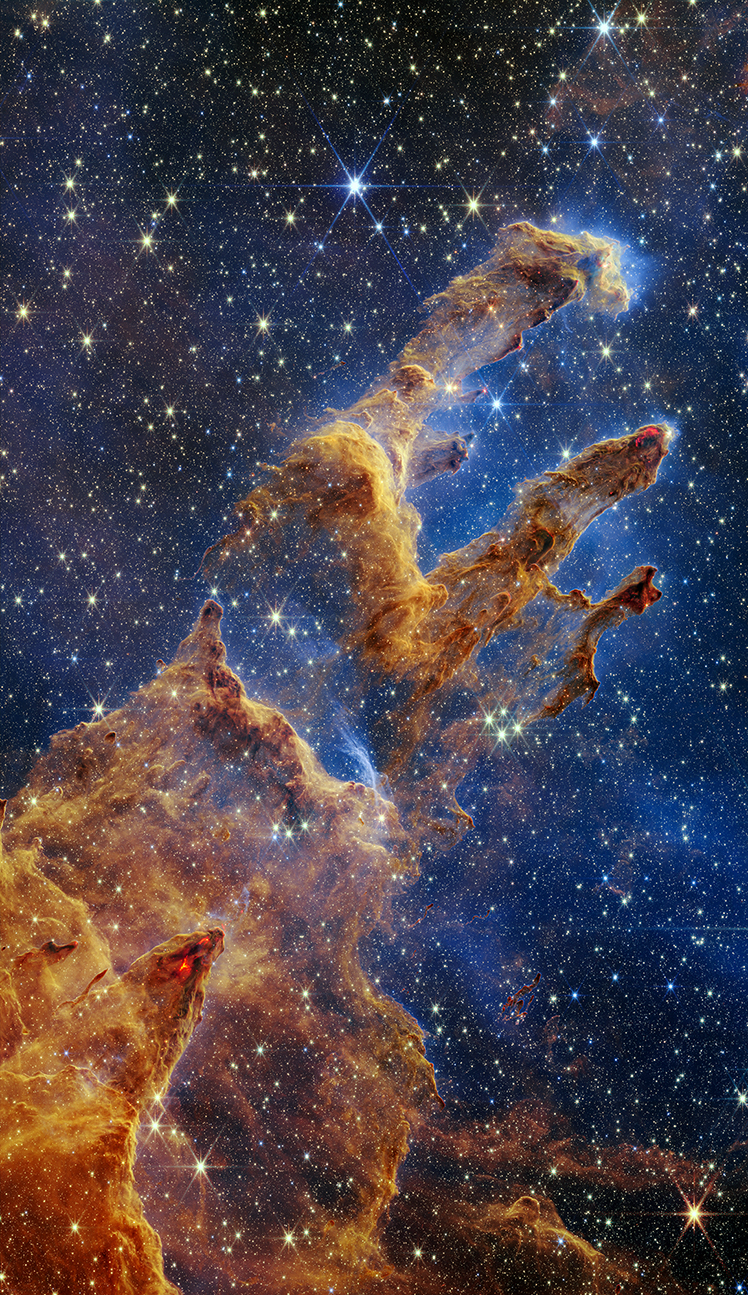
The Pillars of Creation from NASA’s James Webb Space Telescope show a near-infrared-light view. The pillars look like arches and spires rising out of a desert landscape, but are filled with semi-transparent gas and dust, and ever changing. This is a region where young stars are forming – or have barely burst from their dusty cocoons as they continue to form. Credits: NASA, ESA, CSA, STScI; J. DePasquale (STScI), A.M. Koekemoer (STScI), A.Pagan (STScI).
Infrared light penetrates much of the obscuring dust and gas and unveils a more unfamiliar view of the Pillars. Webb’s view of the Pillars of Creation helps researchers revamp their models of star formation by identifying far more precise counts of newly formed stars, along with the quantities of gas and dust in the region. Over time, astronomers are building a clearer understanding of how stars form and burst out of these dusty clouds over millions of years.
Newly formed stars are very apparent in the image from Webb’s Near-Infrared Camera (NIRCam) where they appear as bright red orbs that typically have diffraction spikes and lie outside one of the dusty pillars. When knots collect sufficient mass form, they begin to collapse under their own gravity, slowly heat up, and eventually form new stars.
Young stars periodically shoot out supersonic jets that collide with clouds of material, like these thick pillars. This sometimes also results in bow shocks, which can form wavy patterns like a boat does as it moves through water. The crimson glow comes from the energetic hydrogen molecules that result from jets and shocks. These young stars are estimated to be only a few hundred thousand years old.
3D Visualization
Using data from NASA's Hubble and Webb space telescopes, astronomers and artists modeled the iconic Pillars of Creation in the Eagle Nebula (Messier 16 or M16) in three dimensions, creating a movie that allows viewers to fly past and among the pillars. Credit: Producers: G. Bacon and F.Summers (STScI), NASA's Universe of Learning; Visualization: G. Bacon, R.Crawford, J. DePasquale, L. Hustak, D. Kirshenblat, C. Nieves, J. Olmsted, A. Pagan, and F. Summers (STScI), Robert L. Hurt (Caltech, IPAC); Science Advisor: A. McLeod (Durham University); Music: J. DePasquale (STScI)
NASA / NASA's Universe of Learning released a 3D visualization and comprehensive and detailed multiwavelength movie of these towering celestial structures using data from NASA's Hubble and James Webb space telescopes.
The Pillars of Creation, made primarily of cool molecular hydrogen and dust, are being eroded by the fierce winds and punishing ultraviolet light of nearby hot, young stars. Finger-like structures larger than the solar system protrude from the tops of the pillars. Within these fingers can be embedded, embryonic stars. The tallest pillar stretches across three light-years, three-quarters of the distance between our Sun and the next nearest star.
The movie takes you into the three-dimensional structures of the pillars. Rather than an artistic interpretation, the video is based on observational data from a science paper led by Anna McLeod, an associate professor at the University of Durham in the United Kingdom. McLeod also served as a scientific advisor on the movie.
Several stages of star formation are highlighted in the visualization. As viewers approach the central pillar, they see at its top an embedded, infant protostar glimmering bright red in infrared light. Near the top of the left pillar is a diagonal jet of material ejected from a newborn star. Though the jet is evidence of star birth, viewers can't see the star itself. Finally, at the end of one of the left pillar's protruding "fingers" is a blazing, brand-new star.
More at NASA's Universe of Learning.
https://www.universe-of-learning.org/resources/resource-catalog?Project=astroviz
Pillars of Creation Sonification
Image credit: X-ray: NASA/CXC/SAO; Optical: NASA/STScI; Sonification credit: NASA/CXC/SAO/K.Arcand, SYSTEM Sounds (M. Russo, A. Santaguida)
In the “Pillars of Creation” sonification (the translation of data into sound), the sounds are generated by moving horizontally across the image from left to right as seen in optical light from Hubble and X-ray light from Chandra. The vertical position of the recorded light controls the pitch, but it varies over a continuous range of pitches. Particular attention is paid to the structure of the pillars which can be heard as sweeps from low to high pitches and back. The two different "melodies" of optical and X-ray light can be enjoyed individually or simultaneously.
3D Printing: Print a Star-forming Region
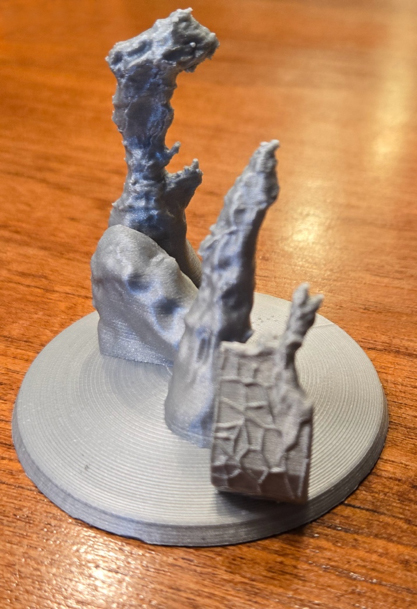
Photo: NASA/CXC/SAO/N.Wolk
The 3D model serves as scientifically informed way of visualizing the Pillars. In 2D images, only 3 pillars (left, center and right) are apparent. However, in 3D, there are four separate clouds within the pillars:
- Pillar 1A is the top part of the left pillar
- Pillar 1B is the bottom part of the left pillar
- Pillar 2 is the central pillar
- Pillar 3 is the right pillar
The 3D sculpted computer model used in the Pillars of Creation visualization was converted to the STL file format and set atop a round base for use with 3D printers.
Select the 3D printer of your choice to make your own Pillars. Download the files below. For the 3D-printed example shown here, one color of PLA filament was used. Support structures were not required. Some post-processing of light sanding and hand-cleaning were required to smooth the edges.
RESOURCES
DOWNLOADABLES
3D Print Your Own Eagle Nebula Handout
LINKS TO OTHER ACTIVITIES
Coding & Astronomy
Recoloring the Universe with Pencil Code
3D Printing
Universe in 3D
Make the Most of Your Universe
Published: April 2024

